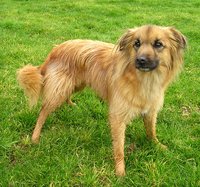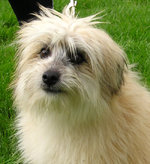Pyrenean Shepherd
|
|
| Pyrenean Shepherd | |||||||||||||||||
|---|---|---|---|---|---|---|---|---|---|---|---|---|---|---|---|---|---|
| Alternative names | |||||||||||||||||
| |||||||||||||||||
| Common nickname | |||||||||||||||||
| Pyr Shep | |||||||||||||||||
| Country of origin | |||||||||||||||||
| France | |||||||||||||||||
| Classification and breed standards | |||||||||||||||||
| |||||||||||||||||
| Notes | |||||||||||||||||
| The AKC Foundation Stock Service (FSS) designation is for rare breeds not currently eligible for AKC registration. |
The Pyrenean Shepherd is a medium-small breed of dog that was bred originally in the 1700s for herding. It often worked as an active herder together with the Great Pyrenees, who acted as the flock's guardian.
| Contents |
Appearance
The smallest of the French herding dogs, the Pyrenean is no more than 22 inches (56 cm) at the withers, with males between 15 1/2 to 22 inches (39-56 cm), and females between 15 1/2 to 20 inches (39-51 cm). The weight is between 18-32 lbs (8-14.5 kg), aiming for muscular, never fat.
The head is of small proportions in comparison to the dog, with a rather flat skull, and a somewhat short, pointed muzzle. The face is expressive and intelligent, with dark eyes, except in the case of the harlequin or slate gray colours. In France, the general choice for the dog's ears is cropped, otherwise, the Pyrenean Shepherd should have drop ears. Naturally prick ears are not of the breed, and may indicate an outcross.
The body is long and lean, and should reflect the natural energetic athleticism of the dog. The legs are well proportioned, with lean, well-bent hocks typical of a sure-footed mountain breed. The tail can be cropped short, naturally short, or naturally long, so long as its carried below the backline at rest and in motion.
Coat
The coat has two basic varieties, smooth-faced (or smooth-haired) and rough-faced (or long-haired). The smooth-faced variety has short, fine hairs on the muzzle, with a modest ruff around the face and neck, and some feathering along the legs, tail, and belly. In contrast, the rough-faced has some long hairs around the muzzle and face, though never enough to cover or obscure the eyes or create a bearded effect, and semilong or long, coarse hair over the rest of the body.
Colour
Shades of fawn are most typical for the breed, either with or without black shadowing, with shades of grey, harlequins in various shades, and the much-rarer black. All colours allow for some white at the head, chest and feet, but clean colours are preferred.
Temperament
The Pyrenean Shepherd was designed to be a sheepdog, and as such is full of the same sort of energy that other herding dogs have, but in a surprisingly small package. This adaptive dog wants to, and can, do all the jobs on the field, and is a natural herder. A dog that needs a job, its cleverness makes it ideal for other work and dog sports such as flyball, competitive obedience and agility.
Pyreneans are "one-man" dogs, attached and dedicated to their owners, with a desire to follow them around the house to help with daily chores. They sense every mood and often seem to be able to read their masters' minds, as they are constantly watchful. Because of this, they are extremely trainable.
Their natural wariness, while valuable in a herding dog that may need to alert their shepherd of strange animals or people, combined with their herding bossiness, can lead to shyness or aggression in even the most friendly puppy if not properly managed. Frequent socialization from a very young age can help counter this trait.
Care
In spite of the shaggy coat, even the rough-faced Pyrenean needs only a weekly brush, as well as regular checks for burrs or knots, to keep its coat in show condition. The coat texture is resistant to tangling, and is quite managable compared to more showy long-haired dogs.
History
After the first World War, the Pyrenean gained national recognition in France for their valiant work as couriers, search and rescue dogs, watch dogs, and company mascots.
The smooth-faced Pyrenean Shepherd in its harlequin or blue merle colouration may have been one of the foundation breeds for the Australian Shepherd in the late 19th and early 20th century.
It is not yet a well-known breed outside of its native France, but its size, intelligence, and attractive coat make it appealing. After one of its breed won the World Agility Championship for midsized dogs in 2003, it gained more attention as an intelligent performance dog for dog sports.
Dog Pictures and Clipart
- Pictures of Dogs (http://classroomclipart.com/cgi-bin/kids/imageFolio.cgi?direct=Animals/Dogs)
- Dog Clipart (http://classroomclipart.com/cgi-bin/kids/imageFolio.cgi?direct=Clipart/Animals/Dog_Clipart)
Clipart and Animal Pictures
- Clipart (https://classroomclipart.com/image/category/clipart.htm)
- Animal Clipart (https://classroomclipart.com/image/category/animal-clipart.htm)
- Animal Animated Clipart (https://classroomclipart.com/clipart/Animations/Animals.htm)
- Pictures of Animals (https://classroomclipart.com/image/category/animal-photos.htm)
- Amphibian Clip Art, Pictures and Photogaphs (https://classroomclipart.com/image/category/amphibian-clipart.htm)
- Farm Animal Clip Art, Pictures and Photographs (https://classroomclipart.com/image/category/farm-animal-clipart.htm)
- Mammal Clip Art, Pictures and Photographs (https://classroomclipart.com/image/category/mammal-clipart.htm)
- Marine Animal Clip Art, Pictures and Photographs (https://classroomclipart.com/image/category/marine-life-clipart.htm)
- Reptile Clip Art, Pictures and Photographs (https://classroomclipart.com/image/category/reptile-clipart.htm)
- Spider Clip Art, Pictures and Photographs (https://classroomclipart.com/image/category/spider-clipart.htm)





